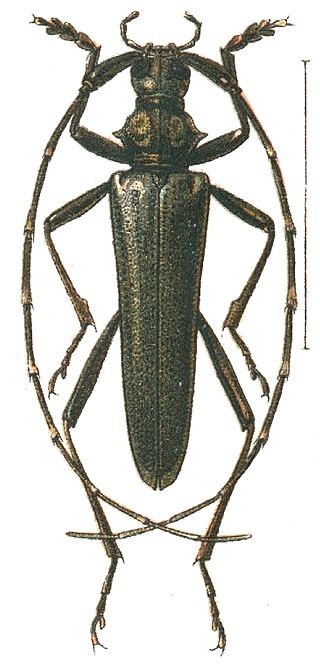
The longhorn beetles (Cerambycidae), also known as long-horned or longicorns, are a large family of beetles, with over 35,000 species described.

The Disteniidae are a small family of beetles in the superfamily Chrysomeloidea, traditionally treated as a group within the Cerambycidae.

Linnei is a railway station on the Taiwan Railways Administration West Coast line located in Linnei Township, Yunlin County, Taiwan.

Carabus linnei is a species of ground beetle in the family Carabidae. It is found in Europe.

Linnei Township is a rural township in Yunlin County, Taiwan. It is the second smallest township in Yunlin County after Baozhong Township.
Homalopoma linnei is a species of sea snail, a marine gastropod mollusc in the family Colloniidae.

Leptothyra is a genus of sea snails, marine gastropod mollusks in the family Colloniidae.
Eupodalecia is a genus of beetles in the family Buprestidae, containing the following species:

Leiopus is a genus of longhorn beetles of the subfamily Lamiinae.

Leiopus femoratus is a species of longhorn beetles of the subfamily Lamiinae. It was described by Fairmaire in 1859, and is known from Bulgaria, the Caucasus, France, northern Iran, southern Russia, and Turkey. The beetles inhabit a variety of deciduous trees, including those in the genera Castanea, Carpinus, Juglans, Ficus, and Tilia. They measure 5-8 millimetres in length, and can live for approximately 1–2 years.
Leiopus kharazii is a species of longhorn beetles of the subfamily Lamiinae. It was described by Holzschuh in 1974, and is known from Azerbaijan and northern Iran. The beetles inhabit deciduous trees. They measure 6-10 millimetres in length, and can live for approximately 1–2 years.

Leiopus nebulosus is a species of longhorn beetle of the subfamily Lamiinae. It was described by Carl Linnaeus in his landmark 1758 10th edition of Systema Naturae. It contains two subspecies; the first, L. nebulosus nebulosus, is known from Europe and Russia, and the second, L. nebulosus caucasicus, is endemic to the mountains of the Caucasus. The beetles inhabit deciduous trees, including those in the genera Fagus, Quercus, Carpinus, Juglans, Acer, Ulmus, Betula, Salix, and Prunus. They measure 5–10 millimetres in length, and can live for approximately 1–2 years.

Leiopus punctulatus is a species of longhorn beetles of the subfamily Lamiinae. It was described by Paykull in 1800, and is known from Europe. The beetles measure 6-8 millimetres in length, and can live for approximately 1–2 years. They inhabit poplar trees, especially the white poplar, but also Populus tremula and Populus nigra. The species is endangered in Central Europe due to a decrease in the white poplar population.
Leiopus syriacus is a species of longhorn beetles of the subfamily Lamiinae. It was described by Ludwig Ganglbauer in 1884, and is known from Syria, Turkey, and Lebanon. The beetles inhabit deciduous trees, including the walnut species Juglans regia. They measure 6-8 millimetres in length, and can live for approximately 2 years.

Trachyderini is a tribe of long-horned beetles in the family Cerambycidae. There are at least 140 genera and 650 described species in Trachyderini.

Lunulicardia is a genus of saltwater clams, marine bivalve molluscs in the family Cardiidae, the cockles. Fossils species in this genus are present in the Pliocene deposits of Indonesia and the Miocene deposits of Russia.

Mulciber is a genus of longhorn beetles of the subfamily Lamiinae, containing the following species:

Neotibicen linnei, commonly called Linne's cicada, is a species of large-bodied annual cicada in the genus Neotibicen. It is native to the Eastern United States and Canada. N. linnei in Oklahoma is most easily identified by the costal margin bent at the end of the radial cell and opercula truncated obliquely at the extremities.
Mulciber linnei is a species of beetle in the family Cerambycidae. It was described by James Thomson in 1864.

Neotibicen winnemanna, commonly called the Eastern scissor(s) grinder, is a species of large bodied annual cicada in the genus Neotibicen. It is native to the Eastern United States, particularly the Piedmont Plateau and the outlying lower mountainous elevations of the Appalachians and inner, western portion of the Atlantic coastal plain.















